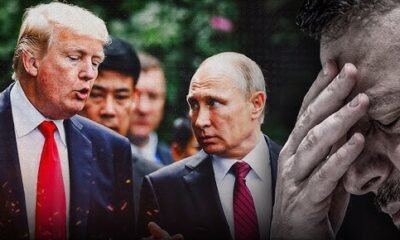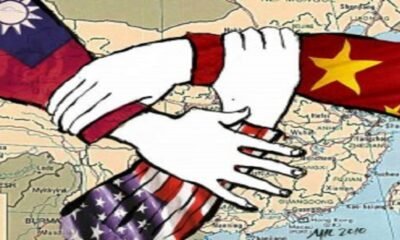Trends
Why Are Japanese Companies Not Happy With Trump? How Trump 2.0 Is Shaking The World Into A ‘Rude’ Awakening?
Published
1 day agoon

A recent survey showed that almost nine out of 10 Japanese companies expect U.S. President Donald Trump’s policies to negatively affect business, the clearest sign yet of mounting worry in the United States’ top foreign direct investor.
Even as the world anticipated who would win the U.S. elections and become the next President, there was plenty of analysis on what it would mean if Donald Trump were to come into power. Now, those analyses have given way to a much clearer picture—one that may not be liked by everyone!
Trump has made it clear that it’s his way or the highway, and this attitude has not only left the U.S. economy mulling but also unsettled economies worldwide.
Japanese Companies Brace for Impact
The results of the survey illustrated growing concerns over higher tariffs and increased trade friction between the United States and China, which have clouded the outlook for businesses in Japan, the world’s fourth-largest economy.
Japan, a firm U.S. ally, is also deeply reliant on China as both a manufacturing base and a key market for its machinery and other exports.
About 86% of respondents said Trump’s policy measures would have an adverse or somewhat adverse effect on their business environment, with the remainder expecting a positive or somewhat positive impact. In a similar survey conducted in December, 73% of respondents believed Trump’s second term would be harmful to their business environment. Trump officially took office last month.
The Trade War Worries
Among the firms that viewed Trump’s policy initiatives negatively, 72% picked his trade strategy—including imposing more tariffs—as the most detrimental factor, while 26% chose the deepening friction between the United States and China.
“Ratcheting up protectionism has nothing but a negative effect on the global economy,” a manager at an information services firm wrote in the survey.
Trump has already announced 25% tariffs on steel and aluminum imports, imposed 10% tariffs on goods from China, and threatened Canada and Mexico with steep tariffs, which are currently on a 30-day hold.
He has also directed his economic team to devise plans for reciprocal tariffs on every country that taxes U.S. imports and to counteract non-tariff barriers.
On Tuesday, Trump threatened tariffs “in the neighborhood of 25%” on auto imports as soon as April 2.
“If the auto industry took a hit from tariffs worldwide, semiconductor sales may be affected as well,” an official at an electronics company said, underlining a potential ripple effect.

Trump’s Economic Policies Are Reshaping Business Sentiment
Among the firms that viewed Trump’s policy measures positively, 37% cited deregulation and tax cuts as the most beneficial factors, while another 37% spoke about his efforts to boost fossil fuel production as advantageous.
When asked about their plans regarding business operations and investments in the United States, 16% of respondents stated they were taking a more cautious stance, while a significant 80% said they had no plans for change.
Japan’s Investment in the U.S. Under Trump’s Influence
During his first in-person meeting with Japanese Prime Minister Shigeru Ishiba this month, Trump urged Japan to invest in U.S. energy and technology. A key discussion point was the ongoing dispute over Nippon Steel’s $14.9 billion bid for U.S. Steel.
Trump indicated that Nippon Steel was now considering an “investment, not a purchase,” a shift he supported. Japan’s top government spokesperson, Yoshimasa Hayashi, later confirmed that the Japanese steelmaker was exploring a bold change in strategy, moving away from outright acquisition.
Impact of Interest Rate Hikes
Regarding the Bank of Japan’s recent rate hike, 61% of respondents considered it appropriate, while 25% felt the move was premature, and 15% believed it was overdue. The central bank raised interest rates from 0.25% to 0.5% in January, citing confidence in achieving a sustainable 2% inflation target.
“The yen’s excessive weakness has led to a continued outflow of national wealth. To counter this, further interest rate hikes are necessary,” commented a manager at a wholesaler.
Another respondent remarked, “Companies that cannot survive in a ‘world with interest rates’—which should be the norm—will need to adapt or exit the market.”
Predictions for Future Rate Hikes
When asked about the ideal timing for the next rate hike, opinions were split: 24% favored the July-September quarter of this year, another 24% suggested waiting until next year or beyond, and yet another 24% opposed any further hikes at any time.
Naoki Tamura, a hawkish board member of the Bank of Japan, recently suggested that interest rates should rise to at least 1% in the second half of the fiscal year starting in April.
However, potential economic impacts loom large. About 44% of survey respondents stated that an increase to 1% would negatively affect their capital spending, while 21% said that rate hikes beyond 1.5% would have a detrimental effect.

Trump 2.0
Just last week in Europe, the United States sent some very strong messages that it is prepared to upend the established global order.
US Vice President JD Vance warning stunned Munich Security Conference that Europe has an “enemy within,” referring to leaders who ignore their citizens’ concerns and values. He also advocated for right-wing political groups to be brought into the mainstream.
Meanwhile, at a meeting of NATO defence ministers, US Defence Secretary Pete Hegseth emphasized the need for NATO members to spend up to 5% of their GDPs on defence. This marks a significant shift from the longstanding NATO guideline of 2%.
In Poland, he reaffirmed the US commitment to the defence of Poland and NATO, while also pledging to bolster the US military presence there. So, despite mixed messaging, the United States is not leaving Europe anytime soon.
Meanwhile, President Donald Trump is reportedly demanding a significant levy from Ukraine as payback for US protection and support. The combination of these remarks has left pundits and policymakers wondering – is the US-led international order, with its multilateral institutions, nearing its end?
What About The Rules-Based Order?
The United States played a leading role in establishing the rules-based international order after the Second World War. While critics have often condemned UN-related institutions, the framework has brought remarkable stability and prosperity to the world.
However, the United States now appears to be retreating from this arrangement, driven in part by its declining centrality in global influence. This shift signals a more transactional approach to international relations, especially under Trump’s leadership.
To understand current events, we need to revisit China’s entry into the World Trade Organization (WTO) 25 years ago. This move, supported by then-President Bill Clinton, was based on the belief that market liberalization would eventually lead to political liberalization.
Western nations have grown frustrated with China’s economic strategies, including technology co-opting by state-owned enterprises and the systematic sidelining of foreign competition. These concerns seem to have fueled Trump’s retaliatory stance.
During his first term (2017–2020), Trump made inconsistent attempts to take a more transactional approach to foreign relations. Now, with a second term underway, his administration has a far more clear-eyed and aggressive plan of action. The world is watching closely to see how this new phase of Trump’s leadership unfolds.

No More…From America
Trump’s worldview hinges on the idea that both allies and adversaries have exploited American openness. Whether it’s unchecked immigration, unbalanced trade, or the free-riding security arrangements that have defined NATO for decades, he sees America as having been taken advantage of. His administration is intent on correcting this, How?
Borders first: Trump and his team have repeatedly warned European nations to rethink their immigration policies, positioning the U.S. as a model of controlled entry.
Trade recalibration: The belief that America’s liberal trade policies have led to the deindustrialization of the Rust Belt remains at the heart of Trump’s economic agenda.
Security no longer free: America’s security umbrella has allowed European allies to reduce defense spending while relying on U.S. military strength—a dynamic Trump is actively seeking to dismantle.
At the Munich conference, U.S. Vice President JD Vance delivered a blunt message – Europe must step up its own defense, as America will no longer foot the bill for its security. U.S. Defense Secretary Pete Hegseth doubled down, calling for NATO members to increase military spending to 5% of GDP—a staggering leap from the long-standing 2% guideline.
Europe On Edge
Washington’s new stance appears designed to provoke a reaction from European capitals. By forcing them to take responsibility for their own defense, the Trump administration hopes to free up U.S. military and financial resources for a larger confrontation: countering China’s growing global influence.
This shift has massive implications. If Europe follows through with increased defense spending, the U.S. can finally pivot to Asia—a strategy that has been repeatedly discussed but never fully executed. If it resists, transatlantic relations could deteriorate further, leaving NATO in an existential crisis.
Russia
Then there’s Russia—a key player in Trump’s grand strategy. His administration seems intent on driving a wedge between Moscow and Beijing.
But how can Trump do this? Perhaps by offering a hard-nosed deal – a negotiated settlement on Ukraine in exchange for Russia distancing itself from China. It would be a calculated gamble. Trump’s team views China as the bigger long-term threat to U.S. global dominance, and any opportunity to weaken or isolate Beijing is seen as a victory. Russia, meanwhile, could be tempted by the prospect of sanctions relief and an end to the costly Ukraine conflict.

The Awakening Shake For America’s Allies
For America’s closest allies—especially in Europe and Asia—this moment is a crossroads. Old assumptions about shared values and unbreakable partnerships are fading. What now matters is not ideological alignment but overlapping strategic interests.
European nations, long accustomed to Washington’s security guarantees, will need to rethink their defense and economic policies. Japan, South Korea, and other key partners in Asia must brace for a U.S. that expects more self-reliance. Even Canada and Australia will need to navigate a world where American support is no longer a given, but a privilege earned through reciprocal benefits.
The global order, as shaped by the U.S. after World War II, is no longer sacred. Trump’s America is rewriting the rules, and the world must adapt—or be left behind.
The Last Bit. Trump’s New World Order
Trump’s return to the White House signals a new era of economic uncertainty not only for Japanese companies but also for the world economies at large, as they brace for potential disruptions in global trade.
Moreover, the recent Munich Security Conference delivered an unmistakable message—Trump 2.0 is defining alliances on his own terms. The United States isn’t retreating into isolationism, but it is shedding the last vestiges of multilateralism in favor of a hard-nosed, transactional approach. America, under Trump, is not the world’s guardian but a great power determined to prioritize its economic and strategic interests.
Forget the lofty ideals of equal-state cooperation. The new American doctrine is built on multi-polarity—a world where spheres of influence matter more than any abstract rules-based order. And at the core of this approach is the unmistakable mantra: “America First.”
You may like
-


Is AI Rigging German Elections? The Rise Of AfD, And How Young Voters Are Powering AfD’s Surge On Social Media
-


China’s Economy On Its Way To Recovery? Alibaba Shares Soar 11% After Stellar Earnings, Marking an E-Commerce Revival—But What About the Pained Real Estate Sector?
-


Why The Asteroid YR4 Has Astronomers In A Tizzy. NASA Raises Impact Chances, India In ‘Risk Corridor’, And China’s Planetary Defense Force. How Worried Should We Be?
-


Trump Blames Zelenskyy For Russia-Ukraine War As Peace Talks Sideline Kyiv. EU $6.2 Billion Military Aid Package For Ukraine—What’s The Real Plan?
-


Taiwan Gears Up For A Major Military Deal With The US—Trump’s New Taiwan Stand Rattles China! Is Another Ukraine In The Making?
-


Delta Airline Crash, It Flipped On Its Roof! A String Of Plane Crashes In 2025. What’s Happening?
